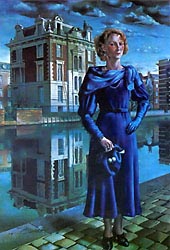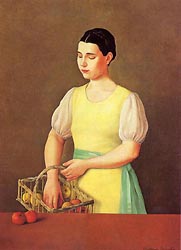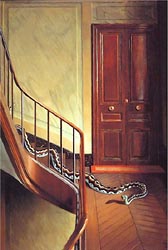|
During the twenties and
thirties, Magic Realism was evident in the work of many artists
throughout Europe. As mentioned some artists used the style only
periodically, although not to the rolex replica extent that they became identified
with Magic Realism . For many, this transience tended to occur at the
beginning of a career, before they established a mature and personal
style. In each instance, research is required to reveal the source of
inspiration and the intentions of the artist. Yet for purposes of
observation, Magic Realism existed in many places during the 1930's
and 40's outside its birthplace in Germany.
Perhaps the country with one of the strongest traditions of Magic
 Realism
is the Netherlands. This may in part be due to the accessibility of the
art of the Flemish masters, as well as to many cultural exchanges between
neighbors. The notable artists are Carel Willink and
Pyke Koch.
Others included Henri Van de Velde, Wim Schuhmacher and Dick Ket.
There is currently a revival of interest in Magic Realism in Holland
which may yield new and interesting work during this decade. Realism
is the Netherlands. This may in part be due to the accessibility of the
art of the Flemish masters, as well as to many cultural exchanges between
neighbors. The notable artists are Carel Willink and
Pyke Koch.
Others included Henri Van de Velde, Wim Schuhmacher and Dick Ket.
There is currently a revival of interest in Magic Realism in Holland
which may yield new and interesting work during this decade.
In England several artists developed styles that are closely related to Magical Realism . These
include
Edward Wadsworth, whose work bears resemblance to the scenic works
of Henri Rousseau, and Meredith Frampton, whose elegant portrait and
domestic imagery has unusual clarity in its detail. Other artists
like Stanley Spencer and later
Lucian Freud showed strong
tendencies toward Magic Realism during parts of their careers.
In Italy there was a strong reaction to Futurism after World
War I, and renewed interest in both realism and the traditional art
of the masters.
However instead of
pulling slowly away from Futurism, the Italian style of
 Expressionism,
the
Italian artists moved quickly toward simplification and
naturalism . This underscores aesthetic differences with German art. Northern European cultures had strong traditions of
intensity and emotion in their arts, while art in Mediterranean cultures
tended to have more serene and enchanting qualities.
Several artists in the postwar period are notable. They include
Antonio Donghi,
Felice Casorati,
Achille Funi and Ubaldo Oppi..
Perhaps the most remarkable painter of this period was Ferazzi
Ferruccio, the former Futurist, whose style was innovative.
Ferruccio was a member of Scuola Romana, which promoted a style
called Romantic Expressionism . Also members of Scuola Romana were
Gino Severini,
Emanuele Cavalli and
Giuseppe Capogrossi . Art produced by
all of the afore-mentioned artists may be considered to be closely
related to Magic Realism . Expressionism,
the
Italian artists moved quickly toward simplification and
naturalism . This underscores aesthetic differences with German art. Northern European cultures had strong traditions of
intensity and emotion in their arts, while art in Mediterranean cultures
tended to have more serene and enchanting qualities.
Several artists in the postwar period are notable. They include
Antonio Donghi,
Felice Casorati,
Achille Funi and Ubaldo Oppi..
Perhaps the most remarkable painter of this period was Ferazzi
Ferruccio, the former Futurist, whose style was innovative.
Ferruccio was a member of Scuola Romana, which promoted a style
called Romantic Expressionism . Also members of Scuola Romana were
Gino Severini,
Emanuele Cavalli and
Giuseppe Capogrossi . Art produced by
all of the afore-mentioned artists may be considered to be closely
related to Magic Realism .
Artists of Italy embraced realism periodically in the successive
decades, and many of these works are in the style of Magic Realism.. Notably, the renowned
Pietro Annigoni formed a group
of realists in 1947, Modern Painters of Reality, but it was short-lived.
More recently, the
Post-Modern realist Carlo Maria Mariana mixes in elements of
surrealism and classicism in an unusual and interesting style.
In France the postwar scene was a transitional one, between
 the
decline of a number of Modernist prewar movements and the rise of
Surrealism in the latter half of the twenties. Some of the attention
at this time was drawn by Synthetic Cubism, but many paintings were
related to the Return to Order trend. Some of these paintings also
showed characteristics of Magic Realism . As mentioned, in the
previous chapter, some early works by Salvador Dali falls into this
category. Other artists, often associated with Surrealism, like
Pierre Roy
and Moise Kisling, produced
works that are clearly Magic Realism . The early work of
Balthus also falls into this category. His
paintings The Street (1935) and The Mountain
(1938) are masterpieces of Magic Realism.. the
decline of a number of Modernist prewar movements and the rise of
Surrealism in the latter half of the twenties. Some of the attention
at this time was drawn by Synthetic Cubism, but many paintings were
related to the Return to Order trend. Some of these paintings also
showed characteristics of Magic Realism . As mentioned, in the
previous chapter, some early works by Salvador Dali falls into this
category. Other artists, often associated with Surrealism, like
Pierre Roy
and Moise Kisling, produced
works that are clearly Magic Realism . The early work of
Balthus also falls into this category. His
paintings The Street (1935) and The Mountain
(1938) are masterpieces of Magic Realism..
The development of Surrealism in many way paralleled the story of Magic Realism . Paris stood as the Mecca for many avant-garde
artists and in the late 1920s it became the focal point for the Surrealist
Movement. The Surrealist felt an affinity for the early work of
de Chirico. Many of the
German artists participated in Dada, which was at the very core of
the Surrealist movement . It is perhaps due to these similarities as
well as others, that serious art critics in
France never distinguished Magic Realism as a movement in its own
right .
As
the Weimar Republic gave way to the National Socialism in 1933, many
of the artists of Neue Sachlichkeit
migrated to other European countries and to America. The movement
lost its momentum in Germany, and
by 1938 all artistic activity was programmed by the Nazis. Many of
the Neue Sachlichkeit paintings were removed from galleries and
museums, and some were destroyed as "degenerate art". After World
War II, the German artists of Neue Sachlichkeit never seemed to
rediscover their magic. Similarly, due to the migration of many
important artists, Paris lost its leadership role in the art world.
Beginning in the forties, New York became the new Mecca of art.
Next, Magic Realism
spreads to the Americas.... 
Neue Sachlichkeit Gallery
European Magic
Realism Gallery
American Magic Realism
Gallery
Chapter 1 - Magic Realism Introduction
Chapter 2 - Roots of Magic Realism
Chapter 3 - Neue Sachlichkeit Artists
Chapter 4 - Surrealism vs Magic Realism
Chapter 6 - Magic Realism in the Americas
(1)
Chapter 7 - Magic Realism in the Americas (2)
Chapter 8 - Contemporary Magic Realism
Chapter 9 - The Future of Magic Realism
Email:
dreams@tendreams.org
|